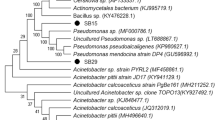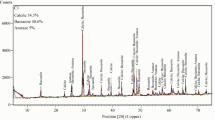Abstract
In the present study, lipase production from mutated strain of Fusarium incarnatum KU377454 was optimized through central composite design (CCD) based response surface methodology (RSM). The maximum lipase production (4.01 IU/mL) was obtained within 4 days of incubation using 0.1% CaCl2 concentration and 8% wheat bran concentration. Further, salting out technique was applied for partial purification of lipase. The partially purified lipase was immobilized using Au@Ag bimetallic nanoshell. The characterization of immobilized lipase was carried out by transmission electron microscopy (TEM), field emission scanning electron microscopy (FE-SEM), Fourier transformed infrared (FTIR), energy dispersive X-ray (EDX), X-ray diffraction (XRD) and thermo gravimetric analysis (TGA). The immobilized lipase could retain its 95% of activity after 15 days of storage at 4 °C. Subsequently, Au@Ag immobilized lipase was used for the degradation of waste cooking oil (WCO), which showed higher WCO degradation (85%) compared to the free lipase mediated waste cooking oil degradation (71%). The immobilized lipase could be reused for five times without any loss of its activity.













Similar content being viewed by others
References
Almeida AF, Dias KB, Silva ACC, Terrasan CRF, Tornisielo SMT, Carmona EC (2016) Agroindustrial wastes as an alternative for lipase production by Candida viswanathii under solid-state cultivation: purification, biochemical properties, and its potential for poultry fat hydrolysis. Enz Res 6:1–15
Amini Z, Ilham Z, Ong CH, Mazaheri H, Wei-Hsin C (2017) State of the art and prospective of lipase-catalyzed transesterification reaction for biodiesel production. Energ Convers Manag 141:339–353
Ban K, Kaieda M, Matsumoto T, Kondo A, Fukuda H (2001) Whole cell biocatalyst for biodiesel fuel production utilizing Rhizopus oryzae cells immobilized within biomass support particles. Biochem Eng J 8:39–43
Bisht D, Yadav SK, Darmwal NS (2013) An oxidant and organic solvent tolerant alkaline lipase by P. aeruginosa mutant: downstream processing and biochemical characterization. Braz J Microbiol 44:1305–1314
Biswas M, Sahoo S, Maiti S, Roy S (2016) Isolation of lipase producing bacteria and determination of their lipase activity from a vegetative oil contaminated soil. Int Res J Basic Appl Sci 1:4–7
Clarissa HOD, Debora ZP, Roselaine F, Marcia MOM, Augusto SN, Cello ZCF, William FZ, Luciana FF (2017) Bioremediation of cooking oil waste using lipases from wastes. PLoS One 12:1–17
Colla LM, Rizzardi J, Pinto MH, Reinehr CO, Bertolin TE, Costa JAV (2010) Simultaneous production of lipases and biosurfactants by submerged and solid-state bioprocesses. Bioresour Technol 101:8308–8314
Cui FJ, Yin L, Xu ZH, Xu HY, Sun K, Tao WY (2006) Optimization of the medium composition for production of mycelial biomass and exo-polymer by Grifola frondosa GF9801 using response surface methodology. Bioresour Technol 97:1209–1216
Das J, Madhawan A, Arora A, Kuila A, Sharma S, Sharma V (2018) Optimization of cellulase production from locally isolated Fusarium incarnatum (Desm.) sacc. Vegetos 31:49–54
Devaraj B, Rajalakshmi G, Komathi S (2018) Optimization and production of lipase enzyme from bacterial strains isolated from petrol spilled soil. JKSUS. https://doi.org/10.1016/j.jksus.2017.12.018
Dizge N, Keskinler B (2008) Enzymatic production of biodiesel from canola oil using immobilized lipase. Biomass Bioenerg 32:1274–1278
Dykman LA, Khlebtsov NG (2012) Gold nanoparticles in biomedical applications: recent advances and perspectives. Chem Soc Rev 41:2256–2582
Goujard L, Villeneuve P, Barea B, Lecomte J, Pina M, Claude S (2008) A spectrophotometric transesterification-based assay for lipases in organic solvent. Anal Biochem 385:161–167
Hirsch LR, Stafford RJ, Bankson JA (2003) Nanoshell-mediated near-infrared thermal therapy of tumors under magnetic resonance guidance. PNAS 100:13549–13554
Hoshino T, Sasaki T, Watanabe Y, Nagasawa T, Yamane T (1992) Purification and some characteristics of extracellular lipase from Fusarium oxysporum f. sp. lini. Biosci Biotechnol Biochem 56:660–664
Hwang S, Lee K, Park J, Min B, Haam S, Ahn I (2004) Stability analysis of Bacillus stearothermophilus L1 lipase immobilized on surface-modified silica gels. Biochem Eng J 17:85–89
Jia P, Zhang M, Hu L, Song F, Feng G, Zhou Y (2018) A strategy for nonmigrating plasticized PVC modified with mannich base of waste cooking oil methyl ester. Sci Rep 8:1–8
Joshi R, Kuila A (2018) Lipase and their different industrial applications: a review. Braz J Biol Sci 5:237–247
Joshi R, Sharma R, Kuila A (2019) Lipase production from Fusarium incarnatum KU377454 and its immobilization using Fe3O4 NPs for application in waste cooking oil degradation. Bioresour Technol Rep 5:134–140
Kai W, Peisheng Y (2016) Optimization of lipase production from a novel strain Thalassospira permensis M35-15 using response surface methodology. Bioengineered 7:298–303
Klaus-Joerger T, Joerger R, Olsson E, Granqvist CG (2001) Bacteria as workers in the living factory: metal-accumulating bacteria and their potential for materials science. Trends Biotechnol 19:15–20
Lee JH, Kim SB, Kang SW, Song YS, Park C, Han SO, Kim SW (2011) Biodiesel production by a mixture of Candida rugosa and Rhizopus oryzae lipases using a supercritical carbon dioxide process. Bioresour Technol 102:2105–2108
Liu CH, Lu WB, Chang JS (2006) Optimizing lipase production of Burkholderia sp. by response surface methodology. Proc Biochem 41:1940–1944
Maqusood A, Mohamad AS, Siddiqu MKJ (2010) Silver nanoparticle applications and human health. Clin Chim Acta 411:1841–1848
Nanou K, Roukas T (2016) Waste cooking oil: a new substrate for carotene production by Blakeslea trisporain submerged fermentation. Bioresour Technol 203:198–203
Narasimhan V, Bhimba BV (2015) Optimization of conditions for the formation of lipase enzyme from Aspergillus brown colored fungi isolated from sun flower oil contaminated soil. Int J ChemTech Res 8:988–996
Oh JM, Lee DH, Song YS, Lee SG, Kim SW (2007) Stability of immobilized lipase on poly(vinyl alcohol) microspheres. J Ind Eng Chem 13:429–433
Padmapriya B, Rajeswari T, Noushida E, Sethupalan D, Venil C (2011) Production of lipase enzyme from Lactobacillus spp. and its application in the degradation of meat. World Appl Sci J 12:1798–1802
Paranthaman R, Alagusundaram K, Indhumathi J (2009) Production of protease from rice mill wastes by Aspergillus niger in solid state fermentation. World J Agric Sci 5:308–312
Popoola B, Onilude A (2017) Microorganisms associated with vegetable oil polluted soil. Adv Microbiol 7:377–386
Rai M, Yadav A, Gade A (2009) Silver nanoparticles as a new generation of antimicrobials. Biotechnol Adv 27:76–83
Ray A (2012) Application of lipase in industry. Asian J Pharm Technol 2:33–37
Samal AK, Polavarapu L, Rodal-Cedeira S, Liz-Marzan LM, Perez-Juste J, Pastoriza-Santos I (2013) Size tunable Au@Ag core-shell nanoparticles: synthesis and surface-enhanced Raman scattering properties. Langmuir 29:15076–15082
Shangguan JJ, Liu YQ, Wang FJ, Zhao J, Fan LQ, Li SX, Xu JH (2011) Expression and characterization of a novel lipase from Aspergillus fumigatus with high specific activity. Appl Biochem Biotechnol 165:949–962
Sharma R, Kumar D (2018) Adsorption of Cr(III) and Cu(II) on hydrothermally synthesized graphene oxide–calcium–zinc nanocomposite. J Chem Eng Data 63:4560–4572
Sharma R, Dhillon A, Kumar D (2018) Mentha-stabilized silver nanoparticles for high-performance colorimetric detection of Al(III) in aqueous systems. Sci Rep 8:5189
Shieh CJ, Liao HF, Lee CC (2003) Optimization of lipase-catalyzed biodiesel by response surface methodology. Bioresour Technol 88:1–13
Sinha K, Kaur R, Bhunia RK (2019) Tailoring triacylglycerol (TAG) biosynthetic pathway in plants for biofuel production. In: Kuila A (ed) Sustainable biofuel and biomass: advances and impacts. CRC Press (ISBN: 9781771888073)
Subathra DC, Mohanasrinivasan V, Jemimah NS, Yamini B, Chitra M, Nandhini G (2015) Strain improvement of Pseudomonas sp.VITSDVM1 for optimization of lipase production by chemical mutagens. RJPBCS 6:782–787
Su F, Li G, Fan Y, Yan Y (2016) Enhanced performance of lipase via microcapsulation and its application in biodiesel preparation. Sci Rep. https://doi.org/10.1038/srep29670
Tan SF, Chee SW, Lin G, Bosman M, Lin M, Mirsaidov U (2016) Real-time imaging of the formation of Au–Ag core-shell nanoparticles. J Am Chem Soc 138:5190–5193
Tran D, Chen C, Chang J (2012) Immobilization of Burkholderia sp. lipase on a ferric silica nanocomposite for biodiesel production. Biotechnology 158:112–119
Tu N, Shou J, Dong H, Huang J, Li Y (2017) Improved catalytic performance of lipase supported on clay/chitosan composite beads. Catalysts 7:1–11
Winkler UK, Stuckmann M (1979) Glycogen, hyaluronate, and some other polysaccharides greatly enhance the formation of exolipase by Serratia marcescens. J Bacteriol 138:663–670
Funding
This work was not supported by any funding authority. It was carried out by our interest.
Author information
Authors and Affiliations
Contributions
Ritika Joshi, Rekha Sharma and Anand Prakash performed all the experiments. Rupam Bhunia and Arindam Kuila planned the work and written the manuscript.
Corresponding author
Ethics declarations
Conflict of interest
The authors declare that they don’t have any conflict of interest in the publication.
Rights and permissions
About this article
Cite this article
Joshi, R., Sharma, R., Bhunia, R. et al. Lipase production from mutagenic strain of Fusarium Incarnatum KU377454 and its immobilization using Au@Ag core shells nanoparticles for application in waste cooking oil degradation. 3 Biotech 9, 411 (2019). https://doi.org/10.1007/s13205-019-1949-4
Received:
Accepted:
Published:
DOI: https://doi.org/10.1007/s13205-019-1949-4




